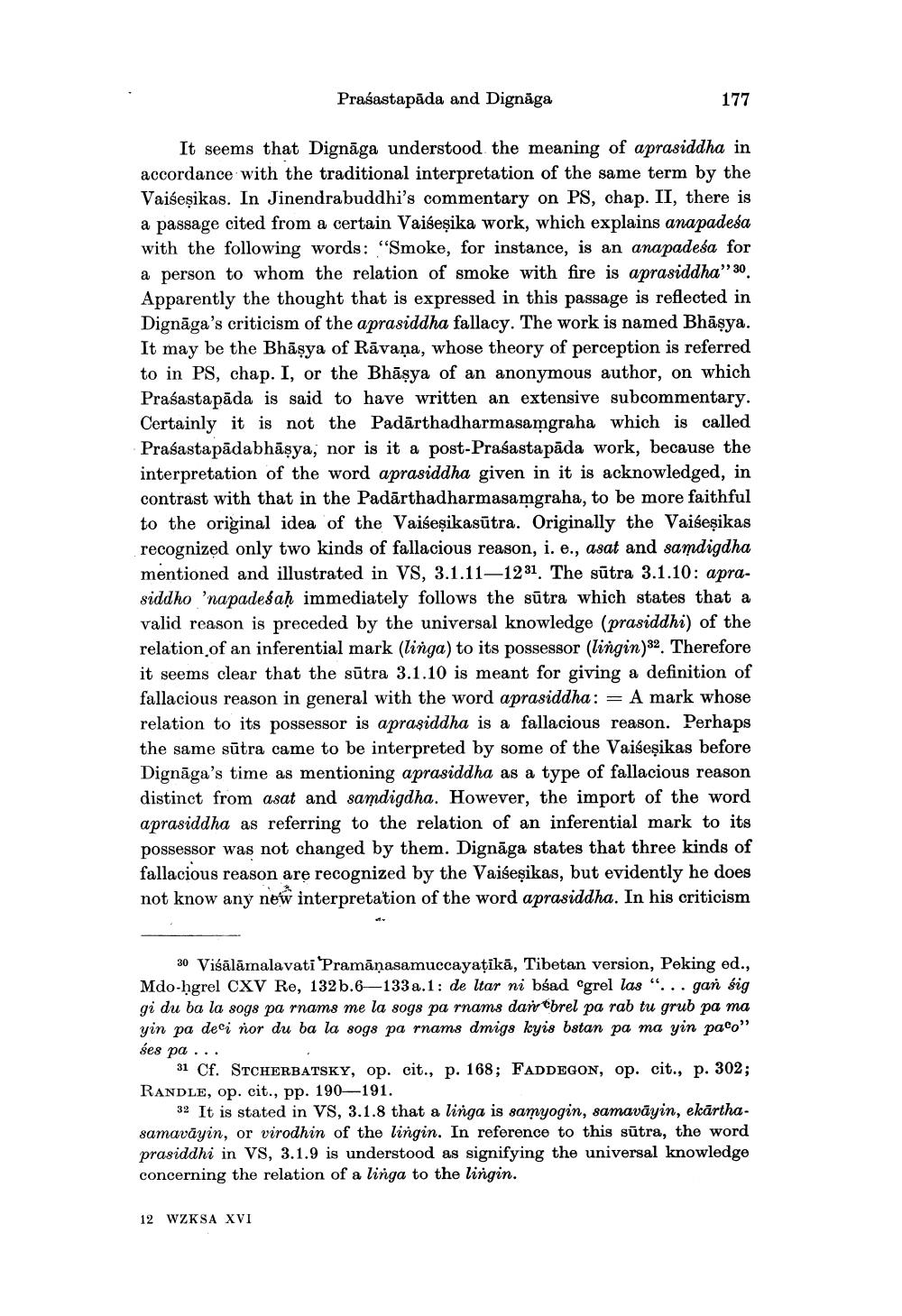Book Title: Note On Development Of Vaisesika Theory Of Anumana Author(s): Masaaki Hattori Publisher: Masaaki Hattori View full book textPage 9
________________ Prasastapāda and Dignāga 177 It seems that Dignāga understood the meaning of aprasiddha in accordance with the traditional interpretation of the same term by the Vaišeşikas. In Jinendrabuddhi's commentary on PS, chap. II, there is a passage cited from a certain Vaiseșika work, which explains anapadesa with the following words: "Smoke, for instance, is an anapadeśa for a person to whom the relation of smoke with fire is aprasiddha"30. Apparently the thought that is expressed in this passage is reflected in Dignāga's criticism of the aprasiddha fallacy. The work is named Bhāṣya. It may be the Bhāşya of Rāvaņa, whose theory of perception is referred to in PS, chap. I, or the Bhāsya of an anonymous author, on which Prasastapāda is said to have written an extensive subcommentary. Certainly it is not the Padārthadharmasamgraha which is called Prasastapādabhāşya, nor is it a post-Prasastapāda work, because the interpretation of the word aprasiddha given in it is acknowledged, in contrast with that in the Padārthadharmasamgraha, to be more faithful to the original idea of the Vaišeşikasūtra. Originally the Vaišeşikas recognized only two kinds of fallacious reason, i. e., asat and samdigdha mentioned and illustrated in VS, 3.1.11—1231 The sūtra 3.1.10: aprasiddho 'napadeśaḥ immediately follows the sūtra which states that a valid reason is preceded by the universal knowledge (prasiddhi) of the relation of an inferential mark (linga) to its possessor (lingin)32. Therefore it seems clear that the sūtra 3.1.10 is meant for giving a definition of fallacious reason in general with the word aprasiddha: = A mark whose relation to its possessor is aprasiddha is a fallacious reason. Perhaps the same sūtra came to be interpreted by some of the Vaišeşikas before Dignāga's time as mentioning aprasiddha as a type of fallacious reason distinct from asat and samdigdha. However, the import of the word aprasiddha as referring to the relation of an inferential mark to its possessor was not changed by them. Dignāga states that three kinds of fallacious reason are recognized by the Vaišeşikas, but evidently he does not know any new interpretation of the word aprasiddha. In his criticism 30 Viśālāmalavati 'Pramāṇasamuccayaţikā, Tibetan version, Peking ed., Mdo-hgrel CXV Re, 132 b.6—133 a.1: de ltar ni bśad Ogrel las"... gan sig gi du ba la soge pa rnams me la sogs pa rnams dar brel pa rab tu grub pa ma yin pa deci nor du ba la sogs pa rnams dmige kyis bstan pa ma yin paoo" ses pa ... 31 Cf. STCHERBATSKY, op. cit., p. 168; FADDEGON, op. cit., p. 302; RANDLE, op. cit., pp. 190 191. 32 It is stated in VS, 3.1.8 that a linga is samyogin, samavāyin, ekārthasamavāyin, or virodhin of the lingin. In reference to this sūtra, the word prasiddhi in VS, 3.1.9 is understood as signifying the universal knowledge concerning the relation of a linga to the lingin. 12 WZKSA XVIPage Navigation
1 ... 7 8 9 10 11 12
